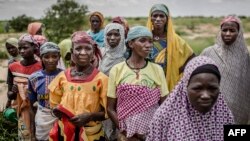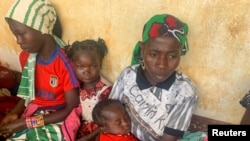
MARADI REGION, NIGER — The west African country of Niger hosts more than 303,000 refugees and asylum-seekers, most fleeing violence from neighboring Nigeria.
In the southern Maradi region, the U.N.’s refugee agency (UNHCR) and aid group Save the Children have set up camps to help refugees stay safe from the border while also easing the burden on their host community.
At a dusty playground at Garin Kaka refugee camp in southern Niger, young children spin on a merry-go-round and clamber on a metal climbing frame.
The camp, in a patch of scrubland in southern Niger, is home to around 4,000 refugees who have fled violence from Islamist militants and bandits in neighboring Nigeria.
It’s one of three camps the U.N.’s refugee agency set up in Niger’s Maradi region since 2019 as what it calls an “opportunity village.”
Refugees at these camps, the first of their kind in Niger, have been moved further from the border, for their safety, and both the refugees and the local population receive aid.
The idea of giving aid to locals is to reduce their burden from the refugee population and ease any tensions that might otherwise arise from competing for resources.
Refugee women are also given small grants to set up shops so they can take care of their families.
Forty-two-year-old Nigerian Hanetou Ali fled her village three years ago on foot with her 11 children after Islamist militants attacked and began killing her neighbors.
She said when militants chased them, she and her family ran. But militants caught a man and his wife, Ali said, and cut him to pieces. You could see the blood streaming, she said, and people had to collect the pieces to bury him.
Safe in the camp since 2019, Ali used a grant to set up shop selling vegetables, salt, and cooking oil.
Aid group Save the Children runs services in the camp.
The group’s Ilaria Manunza said it’s just as important to support refugees as it is the locals, who are under increasing pressure from climate change.
"We also believe the host population still needs and requires some support, so we cannot forget about the host population, the fact they were hugely welcoming and supportive of the refugees," Manunza said. "Therefore, all our interventions should always target both the population of refugees and the host populations."
Aid groups hope refugees in the so-called Opportunity Villages will eventually become self-sufficient.
But some of the refugee women say they are unable to grow their business because there is not enough demand for their services in the camp.
Forty-year-old Nigerian mother of six Jameela Salifou also arrived in Garin Kaka camp three years ago after armed men attacked her village.
She makes a living mending clothes with a sewing machine.
Salifou said sometimes they make enough money to buy cassava flour, but it is not every day that they have business. She said this is how they survive; with the small amount (of money) they get, they manage because they are proud of their business. Salifou said if she earns something, she can use it to not only buy food but also to protect the dignity of her family.
The U.N.’s refugee agency (UNHCR) said conflict in northwestern Nigeria has forced more than 80,000 Nigerians to flee to Niger’s Maradi region. Nearly 18,000 refugees have been moved into the three camps with the Opportunity Village model.
Aid groups said if the model is successful in helping the refugees to integrate and start news lives, they could soon be set up in other countries in the region.




